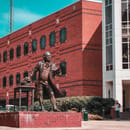This semester I took the class Conservation Biology. As part of our class we were able to meet the staff of Ringling Brothers and get a behind the scenes tour of the facilities. The circus has come to GMU many times before, and this year was no different. They set up in the back of EagleBank Arena and camped out for the next week and a half of performances. I will admit that I did not have a positive viewpoint of the Ringling Brothers Circus due to negative media posts that were circulating around. However we met Wendi, a biologist who travles with the circus and she explained that Ringling Brothers had a Center for Elephant Conservation located in Florida and that is where she had spent some time as well. Conservation of the endangered Asian elephant is one of the main goals of the Ringling Bros. and Barnum & Bailey Center for Elephant Conservation. Ringling Bros. has the largest herd of Asian elephants in the Western Hemisphere which allows them to perform ground-breaking research in assisted reproduction in Asian elephants. For those who aren’t aware, the Elephant acts will be removed from all Ringling Bros performances starting in May. This means the Elephants that have been performing for however long will now go and retire in the Center for Elephant Conservation in Florida. Before taking this class I had no idea that Ringling Brothers had any conservation efforts in terms of their animals. Only 2/3rds of their Elephants partake in the shows-and they choose by observing and getting to know each Elephant to see what kind of stimuli they react to and if its something that is affecting them positively.
When we were receiving the tour of the different trainers and settings we got to see the elephants after they were given a bath. The three elephants were throwing sand on themselves and rolling around. The two younger elephants played around with one another and they were also fed. All the while music was playing from their tent. The trainer explained that the elephants react to the music positively and that it has to do with their incredible intelligence. He went on to describe how the bullhook is used, which is not how the pictures portray it. Online you will read about how circus trainers use their bullhooks and jab the elephants and such but in reality it is used as a guidance tool-never used to touch the elephant. Think about it this way: the elephant is way bigger than you so when you’re training an elephant they need to be able to see cues to learn. A human’s arm is not long enough for the elephant’s peripherels to pick up-therefore the bullhook is essentially used as an extension of the arm. An elephant has great power so if (s)he ever feels threatened they can easily kick you and kill you. These trainers put in their lives for these animals and as we were meeting the elephant staff, my professor told us afterwards that the elephant staff we met who have been part of the elephant trainer generation of circus families, found out 10 days prior that they were out of a job as soon as the Elephants go back to Florida. Every single trainer we met that day was passionate and articulate of every little thing they did. The animals were not in horrific conditions and the trainers did not shy away from difficult questions. Overall my experience of going back stage of such a large company gave me a whole new perspective. I no longer am against the Ringling Bros as a whole however there are still certain aspects to the circus that I am not 100% ok with. Media can be deceiving and can easily influence one’s perspective. All in all I am so grateful for my experience and everyone I talked to.

